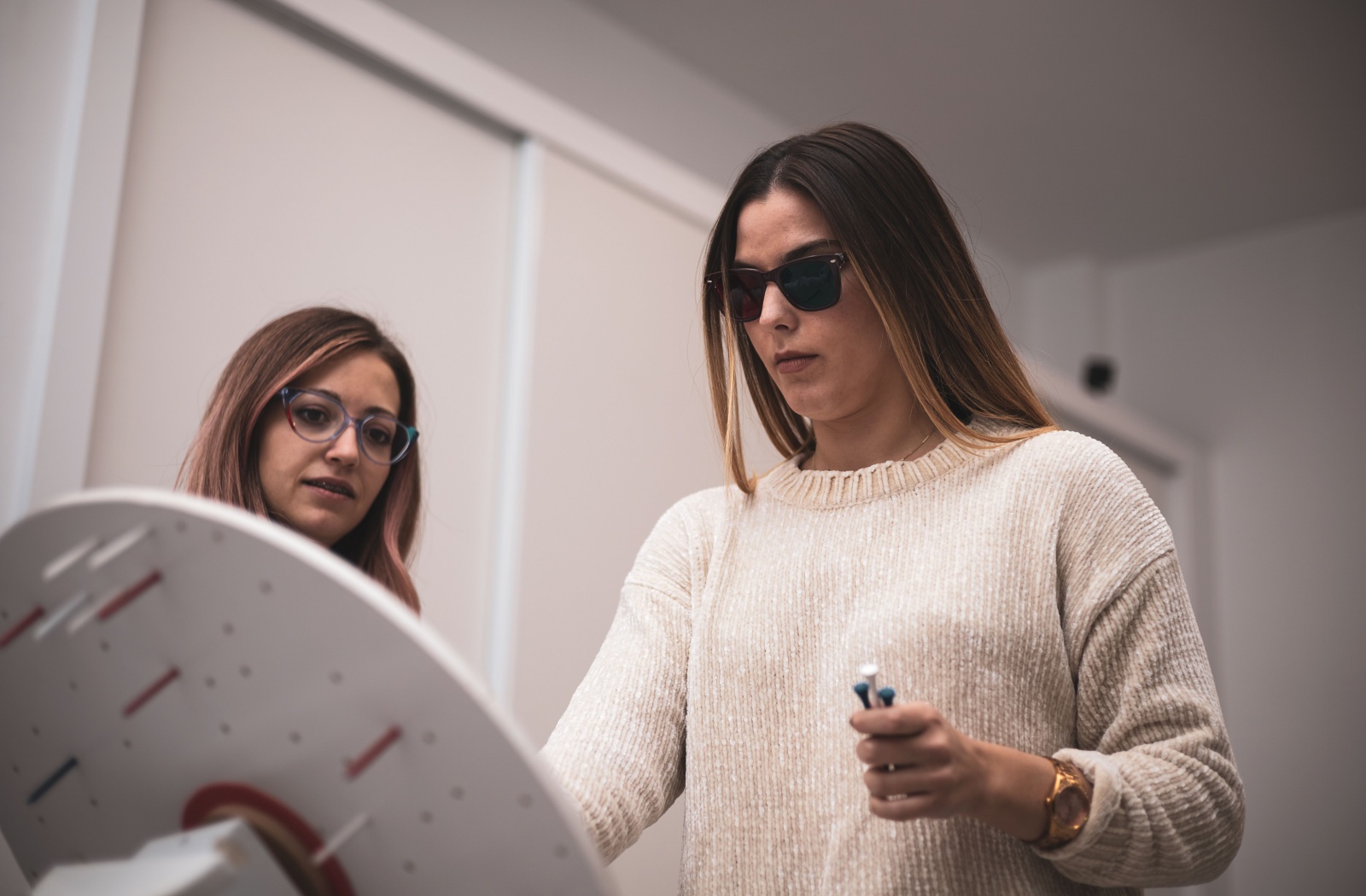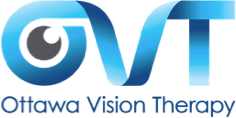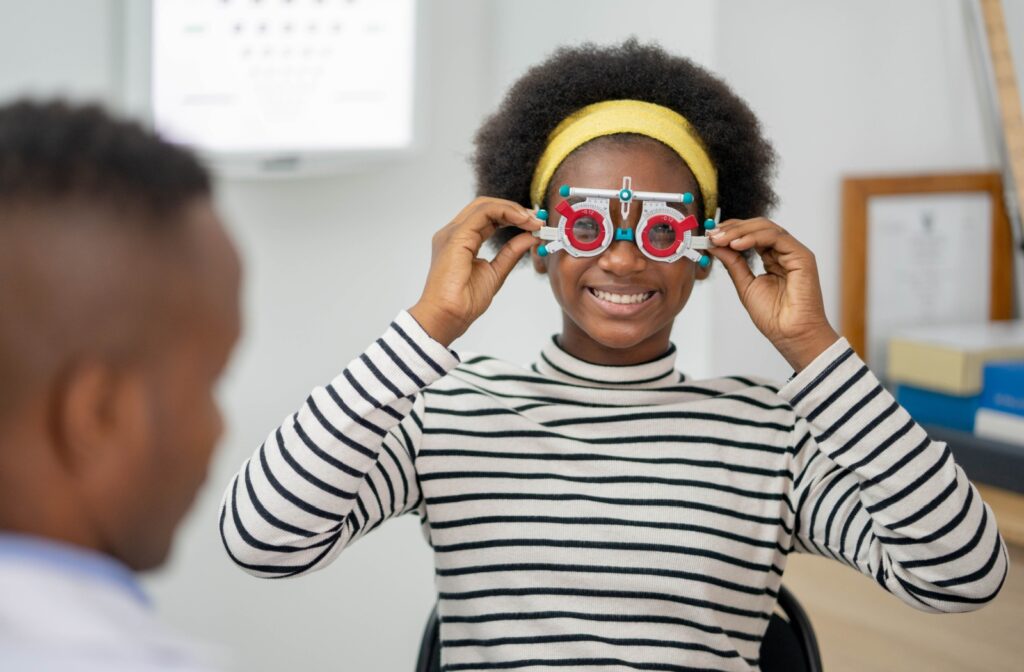Vision therapy is a personalized treatment program designed to improve and strengthen visual skills, enhancing the way the eyes and brain work together. It is a non-surgical approach to correcting various visual problems that affect individuals of all ages.
In this blog, we’ll explore the fundamentals of vision therapy, its benefits, and what you can expect from a vision therapy program.
The Fundamentals of Vision Therapy
Vision therapy, also known as vision training or visual therapy, involves a series of exercises and activities that are tailored to the specific needs of each patient. These exercises are designed to correct and enhance visual functions such as eye tracking, focusing, coordination, and perception. The goal is to improve the overall efficiency and effectiveness of the visual system.
How Vision Therapy Works
Vision therapy programs are typically conducted under the supervision of a trained optometrist or vision therapist. The therapy sessions may take place in an office setting, with additional exercises to be completed at home. Here are the key components of a vision therapy program:
1. Comprehensive Eye Examination
The process begins with a thorough eye examination to assess the patient’s visual skills and identify any underlying issues. This evaluation helps the optometrist develop a customized treatment plan.
2. Customized Treatment Plan
Based on the results of the eye examination, a personalized vision therapy program is created. This plan includes specific exercises and activities designed to address the patient’s unique visual needs.
3. In-Office Therapy Sessions
During in-office sessions, patients work with their vision therapist to perform various exercises using specialized equipment. These exercises may involve the use of lenses, prisms, filters, and other tools to enhance visual skills.
4. Home Exercises
Patients are often given exercises to practice at home between office visits. Consistent practice is essential for achieving the best results from vision therapy.
5. Progress Monitoring
Throughout the therapy program, the optometrist will monitor the patient’s progress and make any necessary adjustments to the treatment plan. Regular follow-up visits ensure that the therapy is effective and on track.
Common Conditions Treated with Vision Therapy

Vision therapy can be beneficial for a wide range of visual problems. Some of the most common conditions treated with vision therapy include:
Amblyopia (Lazy Eye)
Amblyopia occurs when one eye has reduced vision due to poor visual development during childhood. Vision therapy helps improve the visual acuity of the affected eye and enhances eye teaming, which is the eye’s ability to work together.
Strabismus (Crossed Eyes)
Strabismus is a condition where the eyes are misaligned and do not work together properly. Vision therapy can help improve eye alignment and coordination, reducing the need for surgery in some cases.
Convergence Insufficiency
This condition occurs when the eyes have difficulty working together while looking at close objects. Vision therapy strengthens the eye muscles and improves the ability to maintain proper focus.
Eye Tracking & Movement Disorders
Problems with eye tracking can affect reading and other activities that require smooth and accurate eye movements. Vision therapy improves eye tracking skills, enhancing reading speed and comprehension.
Focusing Disorders
Difficulties with changing focus from near to far objects and vice versa can be addressed through vision therapy. This helps improve visual comfort and clarity in everyday tasks.
Visual Perceptual Disorders
These disorders involve difficulties in processing and interpreting visual information. Vision therapy enhances visual perception and cognitive processing, benefiting tasks such as reading, writing, and spatial awareness.
Benefits of Vision Therapy
Vision therapy offers numerous benefits for individuals with visual problems, leading to improved quality of life and overall well-being. Some of the key benefits include:
- Enhanced Visual Skills: Vision therapy strengthens and improves visual skills such as eye coordination, tracking, focusing, and perception. This results in better visual efficiency and comfort in daily activities.
- Improved Academic Performance: For children with visual problems, vision therapy can lead to significant improvements in reading, writing, and overall academic performance. Enhanced visual skills contribute to better concentration and comprehension.
- Reduced Visual Discomfort: Many individuals with visual problems experience discomfort such as headaches, eye strain, and fatigue. Vision therapy helps alleviate these symptoms, leading to greater visual comfort and reduced strain.
- Increased Confidence: Improved visual skills can boost confidence and self-esteem, especially in children. Success in academic and recreational activities can positively impact overall confidence levels.
- Non-Surgical Solution: Vision therapy provides a non-surgical alternative for addressing various visual problems. This makes it a safe and effective option for individuals seeking to improve their vision without undergoing surgery.
What to Expect from a Vision Therapy Program
If you or your child is considering vision therapy, it’s important to know what to expect from the program.
Individualized Approach
Vision therapy is highly personalized, with treatment plans tailored to the specific needs of each patient. This ensures that the therapy is targeted and effective.
Commitment to Practice
Consistent practice of vision therapy exercises is essential for achieving the best results. Patients are encouraged to follow their therapist’s recommendations and complete home exercises as prescribed.
Gradual Progress
Improvement in visual skills may be gradual, and patience is important. Regular follow-up visits with the optometrist will help monitor progress and make any necessary adjustments to the treatment plan.
Collaborative Effort
Vision therapy often involves collaboration between the patient, their family, and the vision therapist. Open communication and active participation are key to the success of the therapy.
Get Started Today
Through a personalized and comprehensive approach, vision therapy can improve visual efficiency, comfort, and overall quality of life. If you or a loved one is experiencing visual difficulties, consider exploring vision therapy as a non-surgical and effective solution.
At Ottawa Vision Therapy, our experienced team is dedicated to providing personalized vision therapy programs tailored to your unique needs. Contact us today and start seeing your life clearly.




